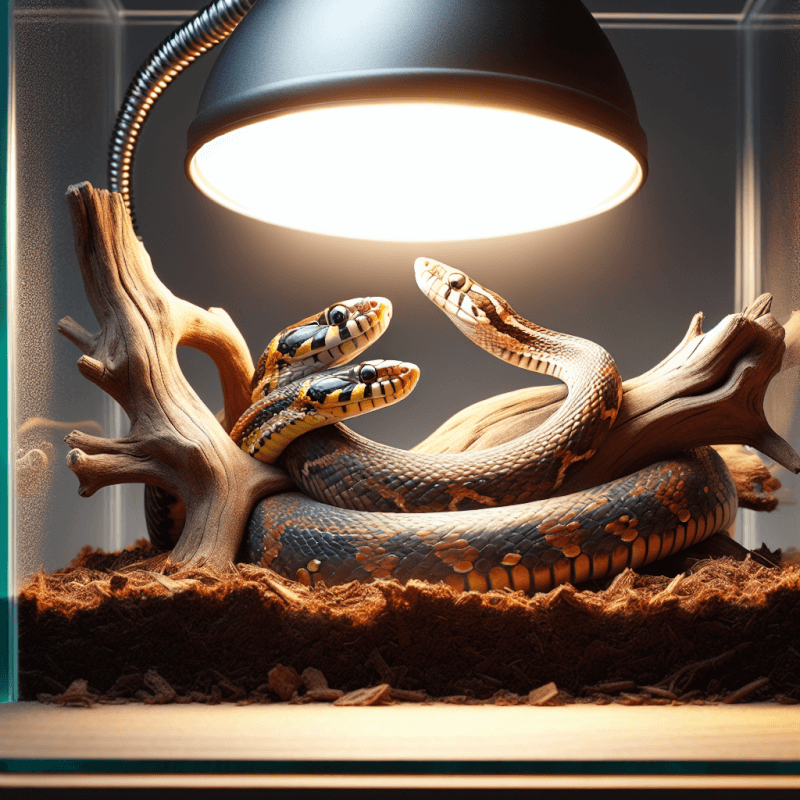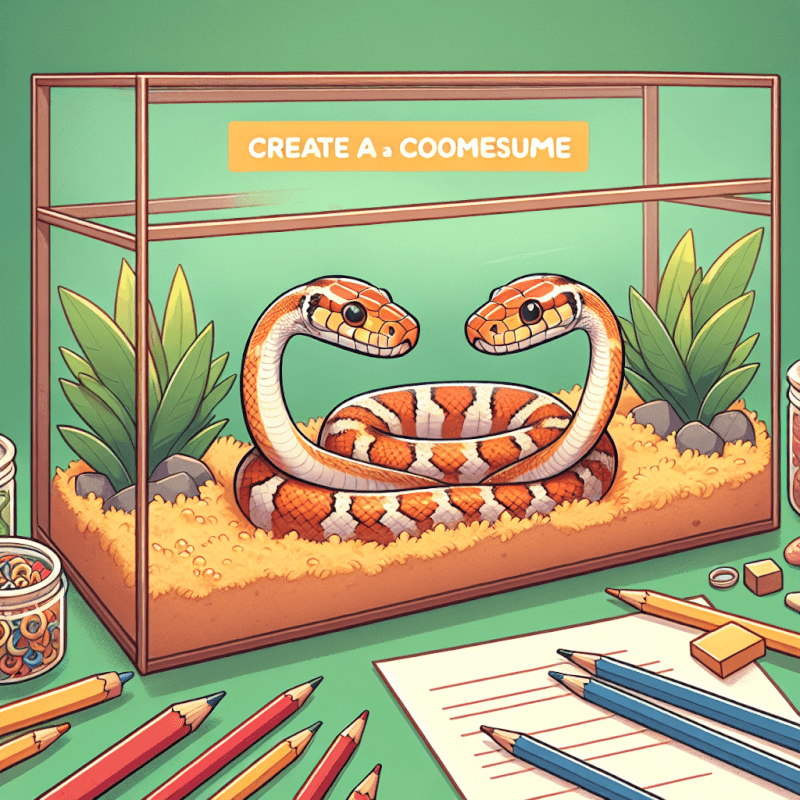Have you ever wondered if it is possible to house two corn snakes together? Well, the answer to this question may surprise you. Many snake enthusiasts have debated this topic for years, with conflicting opinions and experiences. In this article, we will explore the factors to consider when deciding whether to house two corn snakes together and what precautions you should take to ensure their well-being. So, let’s dive into the fascinating world of corn snake cohabitation!
Introduction
Are you considering owning not just one, but two adorable corn snakes? If so, you may be wondering whether it’s possible to house them together. Well, you’re in luck! In this comprehensive article, we will explore the benefits and challenges of housing two corn snakes together. We will also discuss important factors to consider when determining their compatibility, as well as provide tips on setting up the perfect enclosure and ensuring their well-being. So, let’s dive in and discover the world of housing two corn snakes together!
Understanding Corn Snakes
Before we delve into the specifics of housing multiple corn snakes, let’s take a moment to understand these fascinating creatures. Corn snakes, also known as red rat snakes, are popular choices among reptile enthusiasts. They originate from North America and are renowned for their striking appearance, natural habitats, and unique behavior.
Appearance
Corn snakes showcase stunning and diverse patterns, ranging from vibrant reds and oranges to subtle browns and greys. Their scales possess a glossy sheen that enhances their beauty. On average, they grow to be around three to five feet long, making them a manageable size for most hobbyists.
Natural Habitat
Corn snakes are primarily found in the southeastern region of the United States. Their natural habitats include grasslands, forests, and even abandoned buildings. These versatile reptiles are skillful climbers and can be found both on the ground and in trees or shrubs.
Behavior
Corn snakes are known for their gentle temperament, which makes them ideal pets for beginners and experienced reptile owners alike. They are generally docile and rarely display aggressive behavior. However, it is essential to handle them gently and with care to maintain their trust and prevent stress.

Benefits of Housing Two Corn Snakes Together
Now that we have a solid understanding of corn snakes let’s explore the many benefits of housing two of these charming creatures together.
Companionship
Corn snakes, like many other social animals, benefit from companionship. Housing two corn snakes together can provide them with a sense of security and companionship that mimics their natural behavior in the wild. While they may not interact with each other as visibly as dogs or cats, their presence alone can help alleviate loneliness and boredom.
Reduced Stress
Corn snakes, like all creatures, are susceptible to stress. Housing two corn snakes together can help reduce their stress levels. Having a companion in their enclosure can provide a source of comfort and stability, making them feel secure and at ease.
Saving Space
If you have limited space, housing two corn snakes together can be a practical solution. Instead of maintaining separate enclosures for each snake, you can create a shared habitat that allows them to coexist peacefully. This not only saves space but also reduces the effort and resources needed to maintain multiple enclosures.
Challenges of Housing Two Corn Snakes Together
While there are many advantages to housing two corn snakes together, it’s important to recognize and address the challenges that may arise.
Territorial Behavior
Corn snakes, despite their generally docile nature, can display territorial behavior when housed together. This behavior may involve competing for resources, defending preferred hiding places, or even engaging in physical altercations. It is crucial to be aware of these tendencies and monitor their interactions closely to prevent potential conflicts.
Size Considerations
When selecting two corn snakes to cohabitate, size compatibility is vital. Housing snakes of vastly different sizes together can lead to problems, including size-related stress and difficulties in finding appropriate hiding places. Ensuring that the snakes are of similar sizes will promote a more harmonious living environment.
Health Risks
When housing two corn snakes together, there is a higher risk of spreading diseases or parasites between them. Regular health checks and quarantine periods for new additions are essential to minimize these risks. Additionally, maintaining proper hygiene practices within the enclosure is crucial to protect the overall health of both snakes.

Compatibility Factors
To increase the chances of successful cohabitation, several compatibility factors should be considered when selecting two corn snakes to live together.
Similar Size
As mentioned earlier, it is crucial to house corn snakes together that are similar in size. This will ensure that neither snake feels overwhelmed or threatened by the other. Similar-sized snakes are more likely to establish a balanced and harmonious relationship within the shared enclosure.
Similar Age
Pairing corn snakes with a similar age can help promote compatibility. Snakes of the same age group tend to have comparable energy levels and behaviors, making it easier for them to adapt to each other’s presence and establish a comfortable living arrangement.
Same Sex
Housing corn snakes of the same sex together can minimize the risk of territorial disputes or breeding-related conflicts. While male and female corn snakes can live together peacefully, it’s crucial to be prepared for potential breeding behaviors and provide appropriate nesting options if you choose this housing arrangement.
Similar Temperament
Lastly, consider the temperament of the corn snakes before housing them together. Individuals with more relaxed and calm temperaments are more likely to cohabitate successfully. Avoid pairing snakes that display excessively aggressive or skittish behavior, as this can lead to undue stress for both snakes involved.
Setting Up the Enclosure
Now that you have chosen two compatible corn snakes, it’s time to create a suitable and comfortable living environment for them.
Choosing the Right Tank
When housing two corn snakes together, it’s important to provide them with a spacious enclosure that allows for adequate movement and hides. A tank with a minimum size of 40 gallons is recommended for two adult corn snakes. Opt for a horizontally-oriented tank to accommodate their climbing instincts.
Providing Hiding Places
Corn snakes are naturally inclined to seek shelter and hide in their surroundings. To ensure that both snakes have their own space for privacy, it is essential to provide multiple hiding places throughout the enclosure. These hiding spots can be in the form of commercially available reptile caves, hollow logs, or even half-logs.
Maintaining Proper Temperature
Corn snakes are ectothermic, meaning they rely on external heat sources to regulate their body temperature. Maintaining a suitable temperature gradient within the enclosure is crucial for their overall health and well-being. Provide a thermal gradient that ranges from 80-85°F (26-29°C) on the cooler side to 85-90°F (29-32°C) on the warmer side, allowing the snakes to thermo-regulate.
Maintaining Proper Humidity
Achieving an appropriate humidity level in the enclosure is vital for corn snakes, as it helps promote healthy shedding and prevents respiratory issues. Aim for a humidity level of 40-60%, which mimics their natural environment. This can be achieved by misting the enclosure daily and providing a water dish large enough for the snakes to soak in if desired.

Feeding Considerations
Feeding is an important aspect of caring for any snake, and when housing two corn snakes together, there are specific considerations to keep in mind.
Separate Feeding Stations
It is essential to provide separate feeding stations within the enclosure to prevent competition or potential aggression during feeding time. Utilize feeding dishes or designated feeding areas to ensure that each snake can consume its meal without interference.
Monitoring Individual Feeding
Observe the feeding habits of each snake to ensure they are adequately consuming their meals. If one snake consistently refuses or struggles to eat, it may be necessary to separate them during feeding to prevent food competition or stress-related issues.
Avoiding Competition
To minimize competition and potential conflicts between the snakes, it is advisable to feed them at the same time. Synchronized feeding can help establish a routine and reduce the likelihood of aggressive behaviors arising from a perceived threat to resources.
Observing Behavior
Regularly monitoring the behavior of your corn snakes is essential to ensure their happiness and well-being.
Regular Monitoring
Observe how the snakes interact with each other on a regular basis. Look for signs of compatibility, such as coiling together, basking near each other, or exploring the enclosure without any signs of stress or aggression. Regular monitoring will help you identify any potential issues early on and take appropriate action.
Looking Out for Aggression
While it’s normal to see occasional squabbles or territorial behavior, pay attention to any excessive aggression displayed by either snake. Signs of aggression may include hissing, lunging, biting, or prolonged periods of chasing. If aggression occurs, it may be necessary to separate the snakes to avoid injury.
Signs of Stress or Illness
Keep a close eye on your snakes for any signs of stress or illness. Symptoms of stress can include loss of appetite, excessive hiding, pacing, or erratic behavior. If you notice any worrying signs, consult a reptile veterinarian for guidance and assistance.

Alternative Housing Options
If cohabitation proves to be challenging or if you have concerns about the well-being of your corn snakes, alternative housing options can be considered.
Separate Enclosures with Visual Exposure
If you have space constraints or want to provide some level of companionship, you can house the snakes in separate enclosures with visual exposure. This arrangement allows them to see and sense each other, providing a sense of companionship while minimizing the risks associated with cohabitation.
Separate Enclosures without Visual Exposure
Another alternative is to house the snakes completely separately, without any visual exposure to each other. This is particularly advisable if the snakes have displayed aggressive behavior or have health concerns that could be exacerbated in a shared environment.
Rotational Housing
Rotational housing involves periodically swapping the snakes between separate enclosures. This allows each snake to experience different environments and can prevent territorial behavior from becoming too entrenched. However, it is crucial to handle this rotation with care to minimize stress and ensure the well-being of both snakes.
Conclusion
Housing two corn snakes together can be a rewarding experience, providing companionship, reducing stress, and saving space. However, it’s important to consider the challenges and take necessary precautions to set up a suitable enclosure and ensure compatibility. Whether you choose to house them together or separately, always prioritize the well-being and happiness of your corn snakes. By maintaining a vigilant eye, addressing individual needs, and providing appropriate care, you can create a harmonious environment for your corn snake companions and enjoy their captivating presence for years to come.



